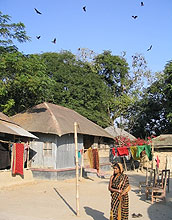All Images


Press Release 08-160
NSF, NIH Award Ecology of Infectious Disease Grants

Scientists to study links between environmental changes, spread of infectious diseases
Back to article | Note about images
 |
Roosting bats in a village in Bangladesh are connected to an outbreak of Nipah virus there.
Credit: Jon Epstein, Center for Conservation Medicine |
Download the high-resolution JPG version of the image. (252 KB)
|
Use your mouse to right-click (or Ctrl-click on a Mac) the link above and choose the option that will save the file or target to your computer.
|
 |
Date-palm gatchers in Bangladesh, who make a living tapping date palm trees and selling the sap as a sweet drink, may be a link between Nipah virus-carrying bats and humans.
Credit: Jon Epstein, Center for Conservation Medicine |
Download the high-resolution JPG version of the image. (299 KB)
|
Use your mouse to right-click (or Ctrl-click on a Mac) the link above and choose the option that will save the file or target to your computer.
|
 |
This army of ticks looking for hosts may be carrying anaplasmosis, an infectious disease in humans.
Credit: Felicia Keesing, Bard College |
Download the high-resolution JPG version of the image. (1.5 MB)
|
Use your mouse to right-click (or Ctrl-click on a Mac) the link above and choose the option that will save the file or target to your computer.
|
 |
EID scientists are studying West Nile virus transmission in songbirds.
Credit: Tony Goldberg, University of Wisconsin-Madison |
Download the high-resolution BMP version of the image. (922 KB)
|
Use your mouse to right-click (or Ctrl-click on a Mac) the link above and choose the option that will save the file or target to your computer.
|
|






